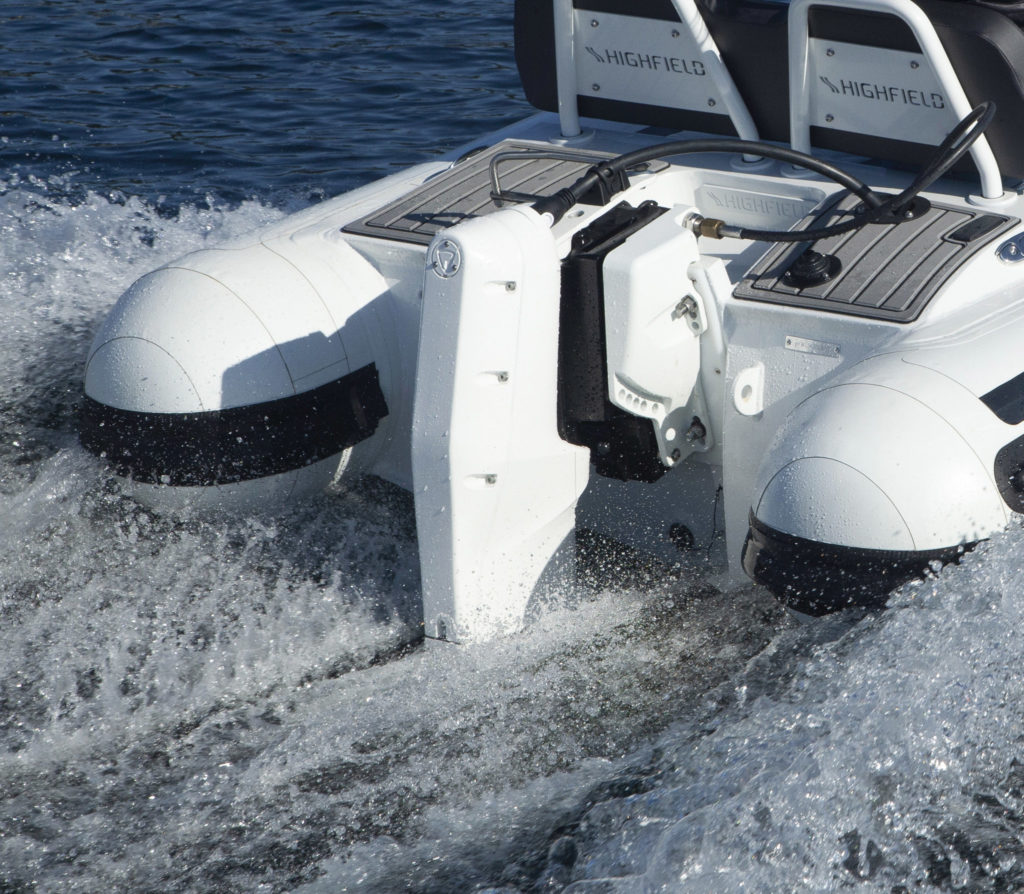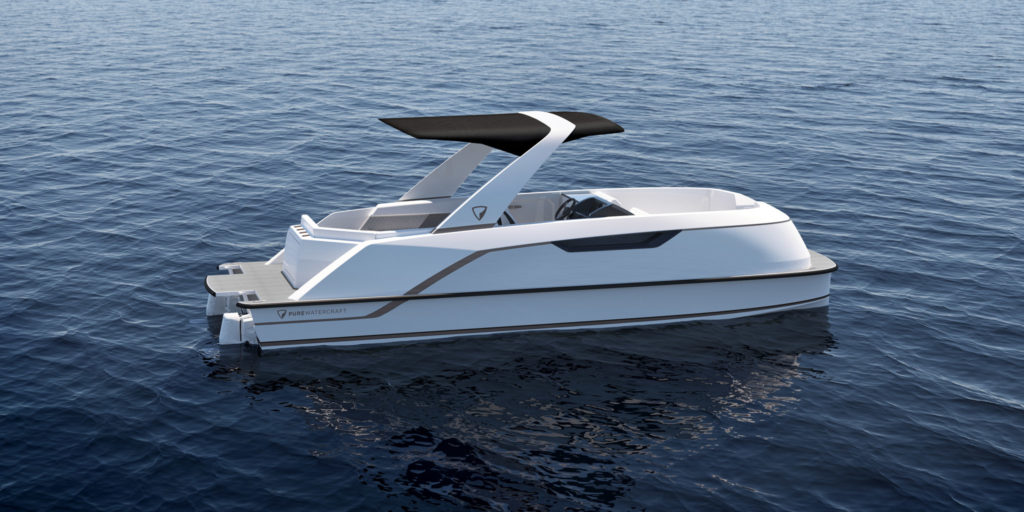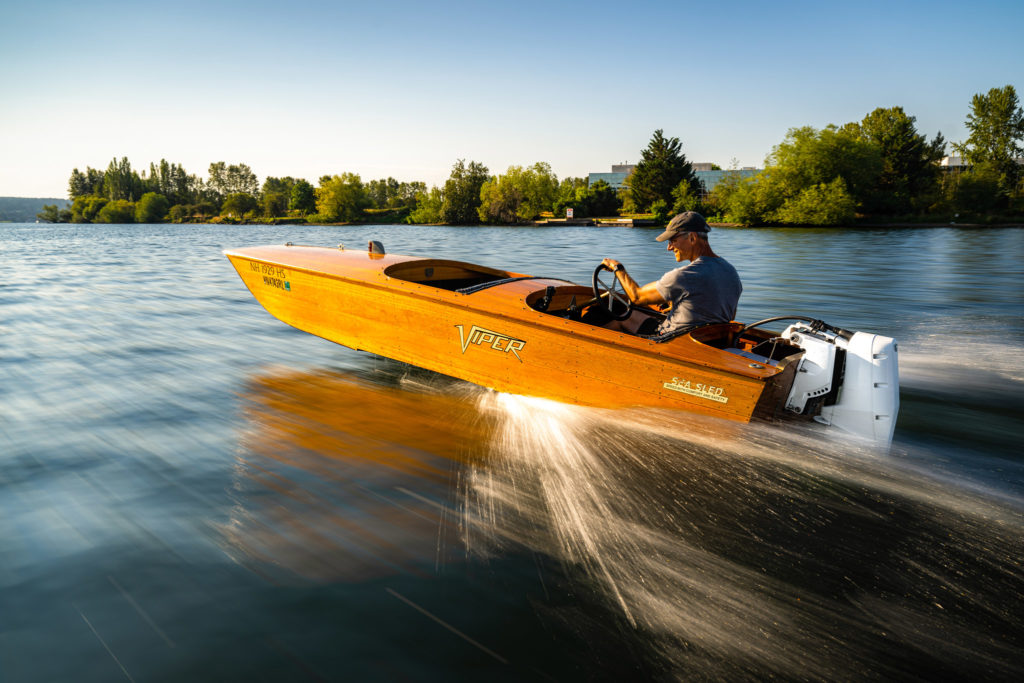
Gliding along the waters of Lake Union on a sunny fall day, the RIB tender gave hints that it was a bit unusual compared to most other small watercraft in Seattle. It was moving at a stately pace of two or three knots, but there were no engine sounds. Only the slight breeze and trickling bow waves could be heard.
This boat has some kick. One flick of the throttle and the RIB sprinted forward, reaching 20 knots in about three seconds. The wind and wave sounds grew louder, but the electric engine emitted a barely audible hum. Long as one held on tight in the lake’s chop, an onboard conversation could easily continue without raising voices.
At the helm was Gabe Johnson, head of marketing for Pure Watercraft, a Seattle-based manufacturer of electric outboard motors that launched in 2011, catering mostly to sport fishing boats and open-bow runabouts. “It’s not like a gas engine, it’s just pure torque,” Johnson said of the electric motor powering our ride that afternoon. “The power’s instantly there, so you just leap out of the water.”
The RIB tender, a 12-foot Highcraft, was created in cooperation with Pure Watercraft, but the chief product of the company over the last decade has been the sleek, low-profile powerplant in the stern. The 25-kilowatt outboard, weighing 112 pounds, uses a series of rechargeable lithium-ion batteries to deliver the rough electric equivalent of a 40 to 50 hp gasoline engine, but produces zero emissions and requires no regular maintenance.
“Any boat that can take an outboard can become electric,” Johnson said. “You can just remove your Mercury, drop in our motor, and bolt it onto the back. There’s nothing special about the boats.”
Yet something quite special will be happening this year regarding Pure Watercraft and boats. Sometime in the second quarter of 2023, the company will begin delivering a new line of boats that could revolutionize the use of electric motors in the United States and bring affordable battery-powered marine propulsion into the mainstream.
Get ready to meet the Pure Pontoon boat. And while the thought of spreading electric power to the world via lumbering aquatic party platforms may not initially seem to get the pulse racing, there is a strategic plan behind this pontoon.

Raising the Platform
The key is market share, said Andy Rebele, the company’s founder and CEO. “Last year, about 70,000 pontoon boats were sold around the country,” Rebele said, which represents about 20% of U.S. recreational boat sales—a figure that has been growing by more than 20% annually. “They’re not fast, so they’re usually used as fishing boats for short excursions.”
More importantly, more than 50% of bookings for pontoon boats were for inland waterways last year, making them attractive beyond the usual boating hotspots on the coasts. “And since Covid began,” Rebele added, “pontoon boats have sold particularly well.”
These trends have not gone unnoticed by some deep-pocketed investors looking for growth in new green markets. In November 2021, Pure Watercraft inked a $150 million deal with automotive giant General Motors, giving it a 25% stake in the company, which is located right on Lake Union. While GM is noted chiefly for its gasoline-fueled cars and trucks, it has committed $35 billion, or 40% of its market cap, to the development of electric and fuel-cell vehicles of many types, including boats and locomotives.
In January 2022, Pure Watercraft debuted the first prototype of Pure Pontoon, using its own battery packs at the Consumer Electronics Show in Las Vegas. The company is now taking pre-orders for the production models, which will use GM’s batteries. The collaboration between e-cars and e-boats, Rebele said, is a natural fit. “GM battery packs don’t have to change when you put them in a boat,” he said. “They’re similar to the ones placed in their cars. And a factory made for pontoon boats is set up exactly the same as a car plant, except the volumes GM can handle far exceed what we could do on our own.”
Under the deal, production of the Pure Pontoons would move from Pure Watercraft’s current Tukwila facility to a larger plant to take advantage of GM’s tremendous economies of scale. Last August, Pure Watercraft announced it will convert a former steel mill in a small town with the colorful name of Beech Bottom, West Virginia, to produce the Pure Pontoons. In turn, GM will supply the batteries and components, co-develop new products, and provide engineering and manufacturing expertise to Pure Watercraft.
While the hilly northern panhandle of West Virginia is not exactly known as a boating mecca, the property on the Ohio River, about 50 miles southwest of Pittsburgh, is well suited for distributing products to inland customers. “The assembly facility site will be ideal for inbound and outbound logistics,” Rebele said. Being more centrally located than factories in coastal cities and situated closer to other GM facilities, Beech Bottom can greatly reduce manufacturing costs, he said.
The converted 80,000-square-foot factory is set to open in late 2025, after a $5 million investment from Pure Watercraft, and expected to create more than 100 full-time positions in an area of Appalachia where new jobs are scarce.
Charging Ahead
But Pure Watercraft will very much remain a Northwest company, despite expanding eastward. Rebele said the company will continue to focus on its core electric technology by producing outboards, battery packs, throttles, and chargers at the current Tukwila facility. It will also continue working with Highfield Boats USA, which supplies the co-branded RIBs specially modified to match the Pure Outboard powertrain, including under-seat and bow lockers that accommodate the integrated battery packs.
The Pure Pontoon design will possess a unique powertrain to really set it apart from other similar e-boats, Johnson said. “Electrics have been around for a while, but the battery packs are kind of our secret sauce,” he said. The 66-kilowatt-hour GM batteries, connected in a series by Pure Watercraft tech, provide more watts per pound than even the famous Tesla automotive batteries. “Watts per pound is the key metric because the power-to-weight ratio is so expensive in a boat,” Johnson explained.
Using a Level I charger, the Pure Pontoon’s batteries can reach a half-to-full charge in 30 hours at 110V, five hours on a Level II charger at 220V, and one hour from zero to 80% capacity with a Level III fast-charger or supercharger. “If you’re tooling along at about three knots, you can go about 45 to 50 hours before you’d need a recharge,” Johnson estimated.
The Pure Pontoon has an overall length of 25’9’ and a capacity for 10 people, with ample bench seating and an optional bimini or hard top. Using Pure Watercraft twin electric outboards, the pontoons can reach a top speed of 23 mph. The range at top speed is 26 miles, or 120 miles at an average speed of 5 mph. The single outboard option can reach 14 mph and has a range of 32 miles at top speed.
“The battery packs are super small and can fit underneath the seats,” Johnson said. “Each one is just about the size of a suitcase. Depending on how you use the boat, each of the packs is equivalent to a three- or four-gallon tank of gas.”
Magic Carpet Ride
GM has vastly improved the manufacturing efficiency of Pure Watercraft’s vision, but the small company made major strides on its own regarding the performance characteristics of the classic pontoon template. “Pontoon boats were never marketed on their efficiency,” Rebele said. “When they move, very little of the hull goes out of the water.”
To solve the problem of needing to push water out of the way, Pure Watercraft streamlined the pontoons to reduce the drag caused by the extra weight of the batteries. The curved point at the bow and the lightweight composite hull material require 20% less power to achieve the same speed as standard aluminum-tube pontoon boats, he added.
The company also added a simple midships foil running abeam between the two pontoons to give it added lift. The foil is fixed and located high enough so as not to affect the minimum draft, so the boat has no need for expensive mechanical foil retraction. “We didn’t know whether the foil would have a significant effect in the prototype, but it ended up being 21% more efficient than boats without a foil, and 50% better than other pontoon boats,” Rebele said. “People describe the foil effect as riding on a flying carpet.”
The Pure Outboard motor used on the pontoon craft also adds to the improved performance. The electric motors are up to 70% efficient, measured as the percentage of energy from the battery pack used for propulsion, not just in motor efficiency. Typical electric outboards range from 35% to 55% overall efficiency, while gasoline outboards achieve only about 5% to 15% overall efficiency.
Even the 16” diameter, three-blade propeller is designed to improve performance. “With electric motors, you can run at a lower rpm but use a larger propeller,” Rebele said. “If you used such a large prop in a gas engine, it might stall out because they have lower torque.” The 1,500-rpm motors are also low in diameter to benefit from passive cooling.
Because there is no impeller in electric engines, Rebele explained, there is no water intake, so they can run equally well in both salt and fresh water, with no need for a seawater loop flush. An electric engine’s gears are always engaged, so there is no need for shifting, which often causes the most wear and tear on gas engines. Pure Watercraft said their engines should last more than 10 years without any additional maintenance.

Green Side Effects
Pure Watercraft believes that the obvious environmental benefits of e-boating are not really the key selling point. The zero emissions aspect of the Pure Pontoon is being marketed almost as a fringe benefit for boaters, who tend to be more concerned with price and performance.
“It isn’t so much that its ‘green,’” Johnson said. “It’s the fact that it’s quiet, there’s no maintenance, and it’s way easier to operate than gas engines.”
When Pure Watercraft began showcasing its pontoon prototype around the country at events like the Fort Lauderdale International Boat Show, “the electric option was still kind of an oddity in the U.S.” Johnson said. “But in Europe, the majority of the focus is on electric.”
Affordability of e-boat technology is also a leading concern at Pure Watercraft. Thanks to the benefits of the GM deal, prices for the pre-orders of Pure Pontoons start at $75,000 for a single outboard and $90,000 for the twin-outboard package.
Finally, Pure Watercraft is capitalizing on novelty—a trait that is universally valued by boaters, regardless of geographic location. The Bluetooth-enabled ergonomic throttle on the Pure Pontoon includes an integrated tilt/trim button and GPS-enabled display screen that shows current state of battery charge, the speed of travel, and the travel time remaining.
“A lot of boating people just love gadgets and love talking about them,” Johnson added. “Electric power is the new toy everybody wants.”
>> For more details on Pure Watercraft, visit: purewatercraft.com.


